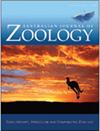Roost use and thermoregulation by female Australian long-eared bats (Nyctophilus geoffroyi and N. gouldi) during pregnancy and lactation1
IF 1
4区 生物学
Q3 ZOOLOGY
引用次数: 2
Abstract
Abstract. Small insectivorous bats commonly use torpor while day-roosting, even in summer. However, reproductive female bats are believed to benefit from avoiding torpor because a constant, elevated body temperature maximises the rate of offspring growth, which could increase offspring survival. We used temperature-sensitive radio-transmitters to locate roosts and document the thermal biology of pregnant and lactating females of Nyctophilus geoffroyi (9 g) and N. gouldi (11 g) at a woodland in a cool temperate climate. Unlike males, reproductive female Nyctophilus spp. roosted as small groups (<25) within insulated tree cavities. Roost switching occurred every 3.7 ± 1.5 (N. geoffroyi) or 1.7 ± 0.8 days (N. gouldi), and radio-tagged individuals roosted together and apart on different days. Skin temperature during roosting was most often between 32 and 36°C, and torpor was used infrequently. Male Nyctophilus have been shown in previous studies to use torpor daily during summer. These contrasting torpor patterns likely reflect the warmed cavities occupied by maternity colonies and the thermally unstable shallow crevices occupied by individual males. Our results support the hypothesis that availability of thermally suitable roosts will influence thermoregulatory patterns of reproductive females and hence the growth rates and survival of their offspring. Thus, it is important to conserve woodland habitat with trees in a range of decay stages to provide opportunities for selection and movement among roost trees by reproductive female bats.雌性澳大利亚长耳蝙蝠(Nyctophilus geoffroyi和N. gouldi)在怀孕和哺乳期间的栖息和体温调节
摘要小型食虫蝙蝠通常在白天栖息时冬眠,即使在夏天也是如此。然而,生殖能力强的雌性蝙蝠被认为从避免冬眠中受益,因为持续升高的体温可以最大限度地提高后代的生长速度,从而提高后代的存活率。本研究利用温度敏感无线电发射机,在温带凉爽的林地中,测定了若虫(9 g)和若虫(11 g)孕期和哺乳期雌虫的栖息地,并记录了它们的热生物学特征。与雄虫不同,雌虫以小群(<25只)的形式栖息在绝缘的树洞中。每隔3.7±1.5天(N. geoffroyi)或1.7±0.8天(N. gouldi)换栖一次,有无线电标记的个体在不同的日子里一起或分开栖息。栖息期间的皮肤温度通常在32 - 36°C之间,很少使用冬眠。先前的研究表明,雄性夜蛾在夏季每天都在冬眠。这些截然不同的冬眠模式可能反映了母蚁占据的温暖洞穴和雄性个体占据的热不稳定的浅裂缝。我们的研究结果支持这样的假设,即热适宜栖息地的可用性将影响生殖雌性的体温调节模式,从而影响其后代的生长速度和存活率。因此,保护处于一系列腐烂阶段的树木的林地栖息地,为生殖雌性蝙蝠在栖息树木之间的选择和移动提供机会是很重要的。
本文章由计算机程序翻译,如有差异,请以英文原文为准。
求助全文
约1分钟内获得全文
求助全文
来源期刊
CiteScore
2.40
自引率
0.00%
发文量
12
审稿时长
>12 weeks
期刊介绍:
Australian Journal of Zoology is an international journal publishing contributions on evolutionary, molecular and comparative zoology. The journal focuses on Australasian fauna but also includes high-quality research from any region that has broader practical or theoretical relevance or that demonstrates a conceptual advance to any aspect of zoology. Subject areas include, but are not limited to: anatomy, physiology, molecular biology, genetics, reproductive biology, developmental biology, parasitology, morphology, behaviour, ecology, zoogeography, systematics and evolution.
Australian Journal of Zoology is a valuable resource for professional zoologists, research scientists, resource managers, environmental consultants, students and amateurs interested in any aspect of the scientific study of animals.
Australian Journal of Zoology is published with the endorsement of the Commonwealth Scientific and Industrial Research Organisation (CSIRO) and the Australian Academy of Science.

 求助内容:
求助内容: 应助结果提醒方式:
应助结果提醒方式:


